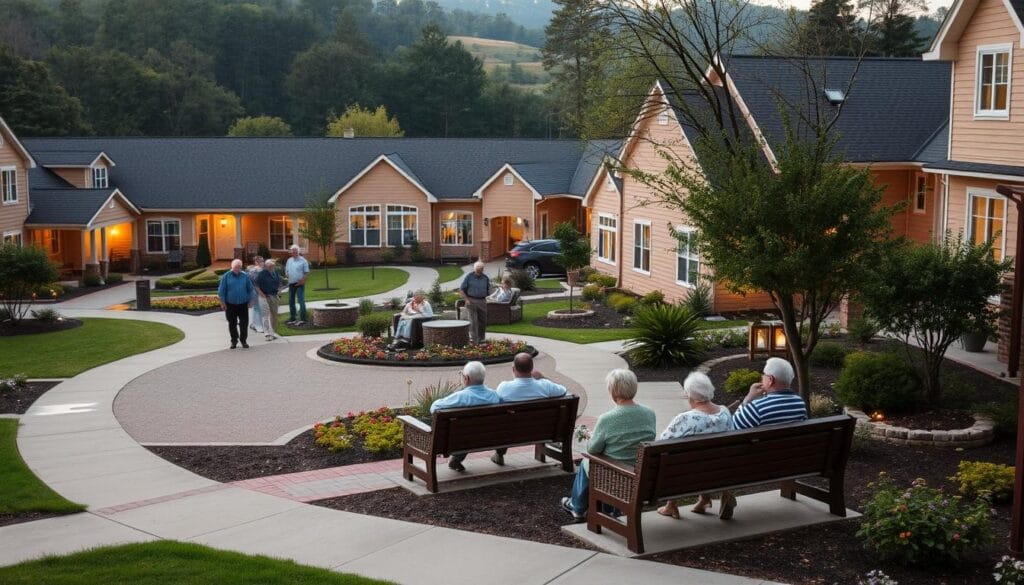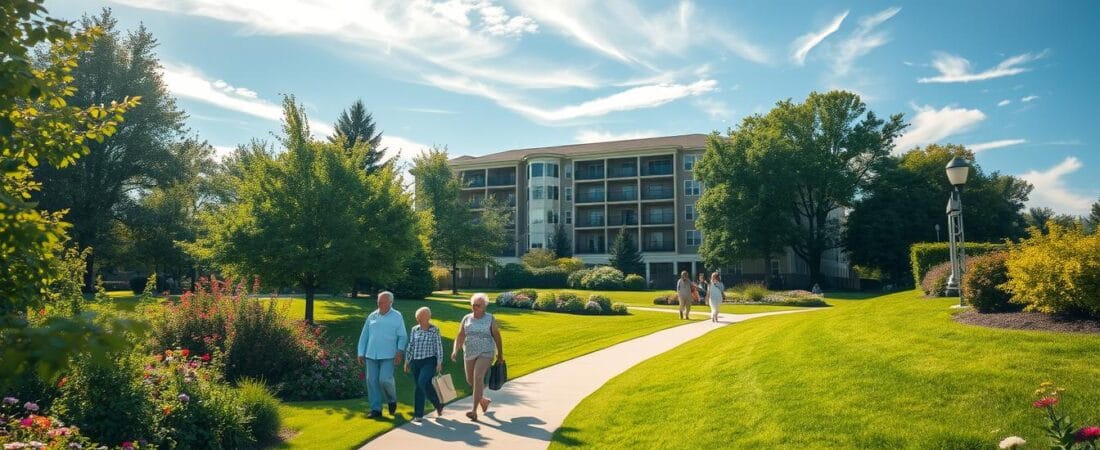Surprising fact: monthly prices for senior housing can span from about $1,600 to more than $16,000 depending on type and location, a range that reshapes planning for many families.
The landscape for senior living varies by level of care, amenities, and geography. Independent living often sits near a national median, while assisted living, memory care, and skilled nursing trend higher.
What raises the price? Apartment size, dining plans, wellness programs, included vs. a la carte services, and on‑site clinical support all play a role. Continuing care campuses may add entrance fees plus monthly service charges.
This guide sets expectations and gives national benchmarks — medians for independent living, assisted living, memory care, and skilled nursing — so readers can compare options and protect quality of life for older adults.
To learn practical next steps on income planning, see tips to maximize Social Security benefits and explore annuity options.
Key Takeaways
- Price varies widely by level of living and location.
- Independent living typically has lower monthly figures than assisted or skilled nursing.
- Facility amenities and service models drive most of the costs.
- CCRCs often require an entrance fee plus ongoing service payments.
- Use national medians as a starting point, not a guarantee.
- Focus on fit: health needs, budget, and desired life on campus.
What the average cost of senior living looks like today in the United States

Today’s bills for senior living are stretching household budgets in new ways. Rising prices for housing, meals, medications, transportation, and utilities push monthly expenses higher, while some service providers trim offerings. A modest Social Security COLA has helped, but medical and energy bills still outpace those adjustments.
Present-day price pressures: inflation, health care, and COLA vs. rising expenses
Medical spending during retirement can total well into the six figures for a couple, shaping when and where families move into a living community. Incremental annual increases often apply to base rent, care plans, and add‑on services.
Buyer’s Guide scope: main types and what they include
This guide compares independent living, assisted living, memory care, skilled nursing, and CCRCs so you can match level of care with needs and budget. Services that affect fees include dining plans, housekeeping, transportation, wellness programming, and medication management.
| Type | Typical Monthly Range | Primary Services | What Raises Fees |
|---|---|---|---|
| Independent living | $1,600–$16,000 | Meals, housekeeping, activities | Apartment size, dining plan |
| Assisted living | ~$5,300 median | ADL help, medication management | Care level, 24/7 staff |
| Memory care / Skilled | $6,100–$9,700+ | Specialized support, nursing | Clinical oversight, private rooms |
Location matters: some states and metro areas charge premiums for similar apartments and services. Get written quotes from specific facilities and factor in add‑ons like second‑person fees, pet fees, and parking to see the total cost of living.
For income planning guidance that pairs with these spending trends, review practical strategies at best retirement income strategies for 2025.
Average cost retirement community breakdown by type and level of care

Understanding how fees vary by type helps families compare options quickly. Below are concise profiles that show typical monthly service ranges and what each level includes.
Independent living communities
Lifestyle-first settings focus on maintenance‑free living, dining, activities, and transport. Unit size, dining plans, and amenities explain much price variability. National medians sit around $3,000–$3,100 per month within a wide $1,600–$16,000 range.
Assisted living
Assisted living centers offer help with ADLs, medication reminders, meals, and social programs. A typical national median is near $5,300 per month, and fees rise as residents need more hands‑on care.
Memory care
Memory units provide secure neighborhoods, tailored programs, and higher staffing ratios. Those specialized services push expenses into roughly the $6,100–$8,200 range compared with standard assisted living.
Skilled nursing
Skilled nursing delivers 24/7 clinical oversight, rehab, and complex medical management. A private room commonly approaches $9,700 per month, making it the most intensive level of care.
Continuing care retirement (CCRCs) and regional snapshots
CCRCs often charge entrance fees ranging from about $50,000 to $450,000+ plus monthly service fees starting near $2,000. Contracts vary (Type A, B, C) and affect predictability when residents shift levels of care.
Regional differences matter: Florida and Arizona generally run below high‑cost states like California and Washington. State medians span from Alabama (~$2,376) to Hawaii (~$5,031), so compare specific offers and request a written line‑item breakdown.
For planning that pairs with coverage options, review long‑term care insurance choices at long-term care insurance options.
Key factors that change your monthly service fees and total care costs
Zip code and local staffing markets can change what you pay each month. Location drives base rent and labor expenses, so the South and Midwest often show lower rates while the Northeast, West Coast, and Hawaii trend higher.
Location and market demand
High housing prices and tight labor markets push rates up in some states. Alabama and parts of the South usually list lower medians, while Hawaii and major West Coast metros sit at the top.
Level of care and services
Moving from independent living to assisted living, memory support, or skilled nursing increases staffing and clinical oversight. That rises line items for personal care, medication management, and therapy.
Amenities, bundles, and contracts
All‑inclusive packages hide add‑ons; a la carte pricing makes comparisons harder.
- Amenities: gourmet dining, fitness, and transport raise monthly figures.
- Contracts: CCRCs may ask for buy‑ins; assisted living often offers month‑to‑month tiers.
- Apartment choice: size, view, and proximity to services affect base rent.
- Ancillary fees: second‑person, pet, and parking charges can add materially to totals.
Demand cycles and low vacancy limit negotiation. Ask each living community for a written rate sheet with line‑by‑line monthly service, care tiers, and à la carte fees to compare offers. For details on assisted living pricing, review this assisted living guide, and for income protection while planning, see top disability insurance providers.
How to budget, compare, and pay for retirement communities
Start by listing every monthly line item so nothing hides in the fine print. That simple step reveals what you already pay and what will change when moving into a senior living community.
Building a realistic monthly budget
Include base rent or entrance fees, care tiers, dining plans, and utilities.
Add internet, transportation, activity charges, pet or parking fees, and likely monthly service adjustments.
Comparing options: community living vs. aging in place
Home upgrades range from $3,000 to $50,000 for ramps, rails, and shower work. That is a one-time investment to weigh against monthly living expenses.
Annual benchmarks help sanity-check totals: assisted living ~ $63,000/year; private duty aide ~ $48,048/year; home health aide ~ $50,336/year; adult day health ~ $18,720/year.
Funding mixes and benefits to explore
Most families use a mix: private pay, long‑term care insurance, state Medicaid waivers where eligible, and VA benefits for qualifying adults.
Tax strategies and medical deductions may lower net spending. Consult a qualified advisor to integrate benefits and investment choices with care plans.
Tools and next steps
Gather apples‑to‑apples quotes that show monthly service, care tiers, and any monthly service fees. Tour multiple senior living communities and talk with current residents about real service quality.
| What to compare | Typical data to request | Why it matters | How it affects budget |
|---|---|---|---|
| Base rent / entrance fee | Monthly rate, buy‑in terms | Defines housing payment | Biggest single monthly service line |
| Care tiers | ADL levels, hourly rates | Drives long‑term care needs | Raises monthly service fees as needs grow |
| Dining & amenities | Meal plans, extras | Impacts daily living quality | Adds predictable monthly expenses |
| Fees & escalation | Pet, parking, second person, escalation policy | Shows future expense risk | Affects budget stability and planning |
For tax-smart savings and account choices tied to long-term planning, see options for Roth providers and tax strategies at top Roth IRA providers for 2025.
Conclusion
Start with the life you want, then match it to clear, line‑by‑line pricing from local providers.
Use national anchors to orient your plan: independent living communities near $3,000/month, assisted living around $5,300, memory care roughly $6,100–$8,200, and skilled nursing near $9,700 for a private room.
Ask each site for an itemized list that shows monthly service, monthly service fees, care tiers, and escalation policies. That clarity helps residents project year‑to‑year expenses and avoid surprises.
Decide whether flexibility or long‑term predictability fits you best: month‑to‑month rentals or a continuing care retirement model with an entrance fee. Balance budget limits with social life, amenities, and on‑site support.
Next steps: shortlist a few retirement communities, schedule tours, check staffing and support, and review contracts with an advisor. For related savings and account options, see top IRA accounts for beginners to align funds with your plan.

